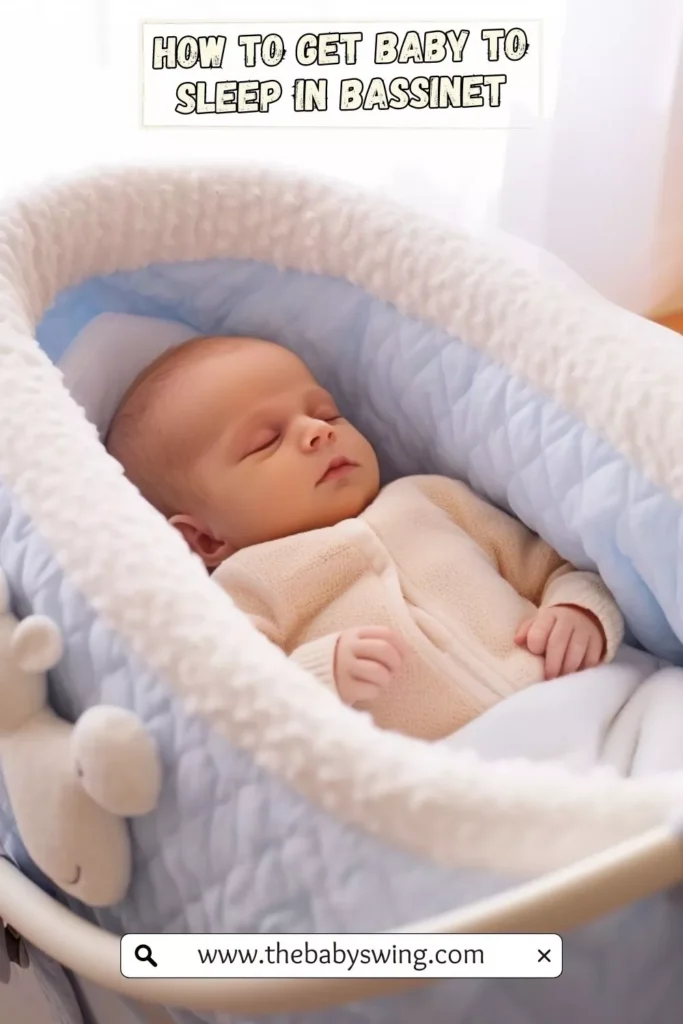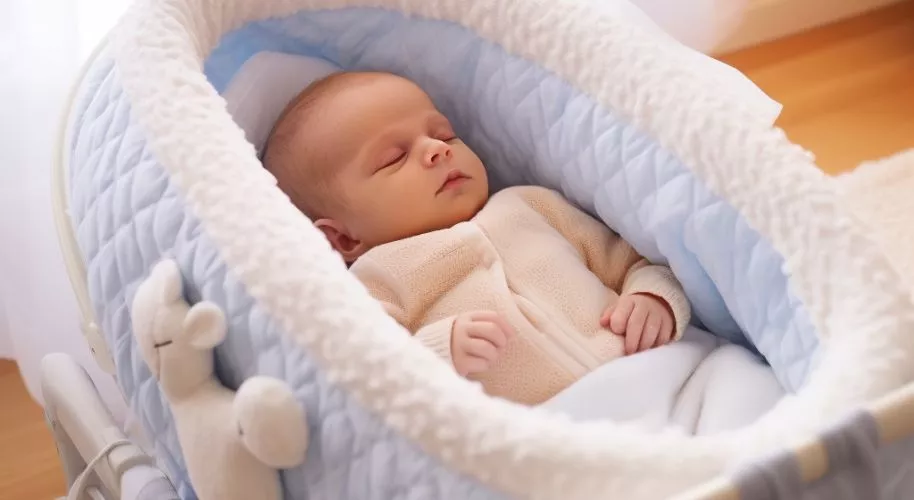Last Updated on August 18, 2023
Getting your baby to sleep in a bassinet can be both an exciting and challenging milestone in your parenting journey. It’s essential for their safety, and it also gives you some much-needed rest.
But how to get baby to sleep in bassinet? That’s a question almost all new parents inquire about.
But how do you make this transition smooth and stress-free? Well, this guide is here to help! We’re going to delve into proven strategies that encourage your little one to sleep comfortably in a bassinet.
From establishing a consistent bedtime routine to creating the optimal sleeping environment, these tips will empower you with the knowledge you need to ensure your baby’s good night sleep in their bassinet. Let’s embark on this peaceful journey together!

How to get baby to sleep in bassinet?
Getting your baby to sleep in a bassinet is a crucial step that can sometimes be a bit challenging. However, with the right strategies and a lot of patience, you can certainly create a comfortable and safe sleeping environment for your little one.
We have consulted with top experts in this field, and they are: Lyndsey Garbi, MD, a double board-certified in pediatrics and neonatology, Dr Charnetta, a board certified pediatrician, and parenting educator and Steph Lee, MD, MPH, FAAP, a board certified pediatrician.
They have provided us with insight as well as a few techniques that can help your baby transition to sleeping in a bassinet!
Don’t let your baby get overheated:
According to Charnetta, an effective method is warming the bassinet before putting your baby down. Overheating can disrupt your baby’s sleep and increase the risk of SIDS. Dress your baby appropriately for the room temperature.
Put your baby flat on his back throughout the day:
This position can help your baby get used to lying flat, making the transition to the bassinet easier. It’s an effective technique for working on the first nap of the day in the bassinet. As per Garbi, “Focus on the timing of sleep. Work on the first nap of the day in the bassinet”.
Try different napping arrangements:
Experimenting with various napping setups can help you find what’s most comfortable for your baby. Garbi recommends, “Try different napping arrangements to make it comfortable for the baby.”
Create a conducive sleep environment:
A dark, quiet, and cool room can enhance your baby’s sleep quality. She also added, “Warming the bassinet with a hot water bottle or beanie before you put your baby down will help this transition”.
Warm the bassinet beforehand:
Warming the bassinet can make it more welcoming and comfortable for your baby.
Place (then remove) a familiar blanket:
The familiar smell of a blanket can comfort your baby and help them relax in the bassinet.
Gradually ease your baby away from your body:
Lee suggests to slowly increase the distance between you and your baby can help them adjust to sleeping alone.
Use the power of routine:
Consistent bedtime rituals can signal to your baby that it’s time to sleep.
Lay Your Baby Down Awake:
This practice encourages self-soothing and helps your baby associate the bassinet with sleep.
Swaddle Them:
Swaddling can provide a sense of security and warmth, similar to being held. This can help your baby get used to the new environment. Swaddling your baby before putting them in the bassinet can also be beneficial.
Charnetta suggests, “If your baby won’t sleep in their bassinet, you might try swaddling them. This will help them settle down, fall asleep, and stay asleep”.
Try a Lullaby or Book:
Soothing sounds or stories can create a calming atmosphere and help your baby drift off to sleep.
Try Bath Time & Infant Massage:
These relaxing activities can soothe your baby and prepare them for sleep. She explains, “When massaged, babies release oxytocin, which calms and soothes them”.
Avoid Rocking Them to Sleep:
Encourage your baby to fall asleep independently to reduce dependency on rocking.
Make the Space More Inviting:
Add soft lighting or play gentle white noise to make the bassinet more appealing. Using sleep cues like darkening the room, playing soft music, and using the same sleep space for all sleep (naps and nighttime) can help signal to your baby that it’s time to sleep.
Simulate Your Embrace:
Use a swaddle or a heartbeat sound machine to mimic the comforting feeling of being held.
Use a firm, flat sleep surface:
This can prevent suffocation and SIDS, ensuring your baby’s safety.
Put your baby on their back for all naps & at night:

This position is the safest for your baby and also reduces the risk of SIDS, according to Lee. A unique approach suggested by her involves initiating the “Calming Reflex”.
She states, “Sometimes standard wind-down tactics are not going to cut it with a newborn who’s fussy and uncomfortable, so try initiating the Calming Reflex technique”
Never sleep with your baby:
Co-sleeping can increase the risk of SIDS. Instead, opt for room-sharing.
Make it a gradual transition:
Slowly introducing your baby to the bassinet can make the transition less stressful.
Offer gentle reassurance:
A comforting touch or soothing words can reassure your baby and help them feel secure.
Give yourself grace:
Remember, it’s okay if things don’t go perfectly. Be patient with yourself and your baby.
Instead of bed sharing, room share with your baby:
Having the baby in the same room but on a separate sleep surface is safer and allows for easy access during nighttime feedings.
Keep soft objects & loose bedding out of your baby’s sleep area:
This reduces the risk of suffocation and SIDS. Remember, every baby is unique and what works for one may not work for another. Be patient, and don’t hesitate to experiment with various strategies until you find what works best for your baby.
You Might Also Like These Resources!
- What To Do If Baby Fell Out Of Swing & Was Dropped On Their Head?
- When should a baby stop using swing
- How long can a baby sleep in a swing for
Why won’t my baby sleep in their bassinet?
There could be several reasons why your baby is resisting sleep in their bassinet. Here are some of the causes and solutions to those issues:
Listed below are a few reasons why your beloved love bundle may not be sleeping in the bassinet-
They’re Uncomfortable:
Your baby might not be accustomed to the feel of the bassinet yet. A soft, comforting blanket might make it more inviting.
Need for Security:
Babies often seek the safety of their parent’s arms. Gradually introducing the bassinet during daytime naps can help them adjust.
They’re Used to Sleeping in Your Arms:
The warmth and rhythm of your heartbeat are soothing. Try holding them close before transitioning them to the bassinet.
They’re Overtired or Undertired:
A well-timed sleep schedule can help balance their sleep patterns, making them more receptive to the bassinet.
They’ve Got Reflux:
If your baby experiences discomfort due to reflux, consider a bassinet with an incline feature to ease their symptoms.
The Startle Reflex or Moro Reflex:
This reflex can wake your baby unexpectedly. Swaddling can help mimic the snugness of the womb, reducing startle awakenings.
It’s Too Quiet or Too Loud:
Babies are used to the noise in the womb. A white noise machine can create a familiar sound environment.
Your Baby is Sick:
Illness can disrupt sleep patterns. Ensure they’re feeling well before transitioning them to the bassinet.
Learned Behavior from the Womb:
Babies are used to constant motion. A gentle rocking motion might ease their transition to the bassinet.
Falling Asleep While Feeding:
If your baby falls asleep while feeding, they might associate sleep with your arms. Try to keep them awake during feedings and establish a separate sleep routine.
Why Is It Important That Babies Sleep in a Bassinet?

Your little one’s sleep is crucial, not only for their growth and development, but also for your peace of mind. Choosing a bassinet as their first sleeping space offers a myriad of benefits!
Mimics the womb:
A bassinet provides a cozy, secure environment reminiscent of the womb, making it easier for your baby to settle and sleep.
Compact in size:
Its compact size means it can be placed closer to your bed, allowing you to respond quickly to their needs during the night. This proximity is particularly beneficial for frequent night feeding sessions.
Moreover, bassinets are lighter and more portable than cribs, meaning you can easily move them around the house, keeping your baby close at all times.
Many models also come with a cover that shields your baby from light and disturbances, promoting deeper, longer sleep.
Built-in safety measures:
Safety is paramount when it comes to your baby’s sleep. The American Academy of Pediatrics (AAP) recommends always placing your baby on their back to sleep, a guideline that can be easily followed in a bassinet.
Bassinets are designed to protect your baby from potential dangers such as choking, suffocation, and Sudden Infant Death Syndrome (SIDS).
In essence, using a bassinet ensures your baby’s comfort, safety, and proximity to you, making those early months a little bit easier.
Tips and tricks for when your newborn keeps refusing to sleep in their bassinet
Still, having trouble settling your child in? You can try these tips and tricks to see what clicks-
Try Bath Time & Infant Massage:
A warm bath and gentle massage can soothe your baby, making them more relaxed and ready for sleep.
Signs a Bassinet Is too Small:
If your baby seems uncomfortable, can’t stretch out fully, or is hitting the sides of the bassinet, it may be time for a larger sleep space.
Rethink your lights:
Dimming lights or using a nightlight can signal to your baby that it’s time to sleep, helping set their internal clock.
Experiment with white noise:
White noise can mimic the sounds in the womb, providing a comforting, sleep-inducing environment for your baby.
Try the washcloth trick:
A warm, damp washcloth on your baby’s forehead can help soothe and lull them to sleep.
The weird tissue trick:
Gently brushing a tissue over your baby’s face can trigger a blink reflex, which may help them close their eyes and drift off to sleep.
Dr. Karp’s 5 S’s:
Swaddle, Side or Stomach position, Shush, Swing, and Suck are five steps that can trigger a calming reflex in your baby, promoting sleep.
The Swing or “Jell-O head jiggle”:
This involves gently rocking your baby in a rhythmic motion, which can mimic the soothing movement they felt in the womb.
Maximize your baby’s daytime feeds:
Ensuring your baby gets plenty of milk during the day can help them sleep longer stretches at night.
Try to get your baby down “drowsy but awake” once a day in the bassinet:
This can help your baby learn to fall asleep independently, promoting better sleep habits.
Sleep patterns change regularly in year one. So, your baby’s sleep will undergo several changes in the first year, so be prepared to adapt your routines and strategies as needed.
Bassinet Safety and Maintenance Rules
Ensuring that your baby is safe while sleeping in a bassinet is crucial. Here are some key safety rules to follow:
Use a Firm Mattress:
The mattress in the bassinet should be firm and fit snugly against the sides of the bassinet to prevent any gaps where the baby could potentially get stuck.
Keep the Bassinet Clear:
The bassinet should be free from toys, blankets, pillows, and other items that pose a suffocation risk.
Place the Bassinet on a Stable Surface:
Ensure the bassinet is on a flat, stable surface where it won’t tip over. Also, make sure it’s not within reach of cords or drapes.
Ensure Proper Positioning:
Always place your baby on their back to sleep. This position reduces the risk of Sudden Infant Death Syndrome (SIDS).
Check Weight Limits:
Always adhere to the weight limit stated by the manufacturer. Once your baby exceeds this limit, it’s time to transition to a crib.
Monitor for Wear and Tear:
Regularly check the bassinet for any damage, loose parts, or wear and tear that could pose a safety risk.
Use a Safety-Approved Bassinet:
Only use a bassinet that meets current safety standards set by the Consumer Product Safety Commission.
Remember, safety should always be the top priority when it comes to your baby’s sleep environment.
What Are Alternatives to a Bassinet?
There are numerous alternatives to a bassinet that provide safe and comfortable sleep environments for infants. These alternatives can be particularly useful as your child grows, or if you’re looking for a more portable or multi-functional solution.
Cribs
Traditional full-size cribs are a prominent alternative to a bassinet. They offer a spacious and sturdy sleeping environment and can accommodate your child as they grow.
No products found.
Mini Cribs
Mini cribs are smaller than standard cribs but larger than bassinets, making them a great space-saving option.
- GREAT CRIB FOR SMALL SPACES OR TRAVEL: Crib includes casters for easy mobility; Folds flat for easy...
- GROWS WITH BABY: The 2 position mattress height adjustment on this crib allows you to lower the...
- BUILT TO LAST: Strong and sturdy wood construction helps create a dream nursery where you’ll spend...
- WE PUT YOUR BABY’S SAFETY FIRST: This crib is JPMA certified to meet or exceed all safety...
Bedside Co-Sleeper Bassinet
These things allow your baby to sleep near you safely, facilitating easier nighttime feedings and comforting.
No products found.
Travel Cribs
These are lightweight, easy to fold, and excellent for families who travel frequently.
- 【Portable Travel Crib】- Our Foldable Travel Crib is spacious enough for babies from 0 to 3 years...
- 【Lightweight & Durable】- The net weight is only 12 lbs. Lightweight, Reliable and built for...
- 【Breathable Mesh】- The Portable Playard sides are made of soft, airy mesh fabric that allow your...
- 【Side Zipper Door】- The sides of this Travel Playard are made from soft and airy mesh fabric,...
Pack N Plays
“Pack N Plays” or also known as playards, these are versatile alternatives that can serve as a safe place for both sleep and play.
- AWARD WINNING FEATURES: A full-size playard, the Nest is spacious, safe and loaded with convenient...
- MOBILE & STURDY: Its lightweight aluminum frame allows easy mobility. Set-up is easy and takes...
- BREATHABLE MESH: The Nest Playard is made of soft and safe polyester foam fabric. Its four airy mesh...
- PRIORITIZING SAFETY, ALWAYS: The Nest Playard meets all applicable CPSC/ASTM standards. It’s...
Moses Baskets
Compact and portable, Moses baskets are a traditional and cozy option for newborns.
- ✔SPINIFLY is Here For Your Family: We Created A Safe Baby Changing Basket For Easy Everyday Use....
- ✔DIAPER CADDY SET Keep All Your Baby's Essentials Organized And Within Easy Reach With This...
- ✔CPSC Tested and Compliant(2024): Extensive Baby Safety Testing Has Been Completed To Ensure Our...
- ✔STYLISH AND CLASSY : Our Baby Changing Basket Station With Boho Baskets for Baby Nursery Design...
Supported Sleep
Some modern devices like smart bassinets provide supported sleep, with features like automatic rocking and white noise generation.
- Rocking Motion - Remote control design with 3 rolling motion, simulate mom's easeful embrace and...
- Safety Standards - CPSC and ASTM certified. Sturdy construction, secure locking mechanisms, and...
- Comfortable Sleep - Mesh sides provide ample breathability and visibility for the baby. The baby...
- All-in-One Motor System: Powers smooth rocking & calming music with a single industrial-grade motor....
Remember, the safety of the sleep environment is paramount. Whichever alternative you choose, ensure it meets safety standards and is appropriate for your baby’s developmental stage.
Bottom Line
In conclusion, navigating the early stages of parenthood involves making important decisions about your baby’s sleeping arrangements. While bassinets are a popular choice, alternatives like cribs, mini cribs, bedside co-sleepers, etc. offer diverse options for different needs.
Regardless of the chosen sleeping arrangement, ensuring a safe, comfortable, and developmentally appropriate environment for your child should be the priority.
Always consult with healthcare professionals for personalized advice. Parenthood is a journey, and each family must find what works best for them.
Sharing is Caring!
You Might Also Like These Latest Content !

Amy A. Vincent is a Certified Pediatric Sleep Consultant and a mother of three beautiful children. She helps parents transition their babies from swing sleep to safe, independent sleep. She is passionate about helping parents teach their children the skills needed to become good sleepers and aims to make the process as easy and stress-free as possible. Read more





